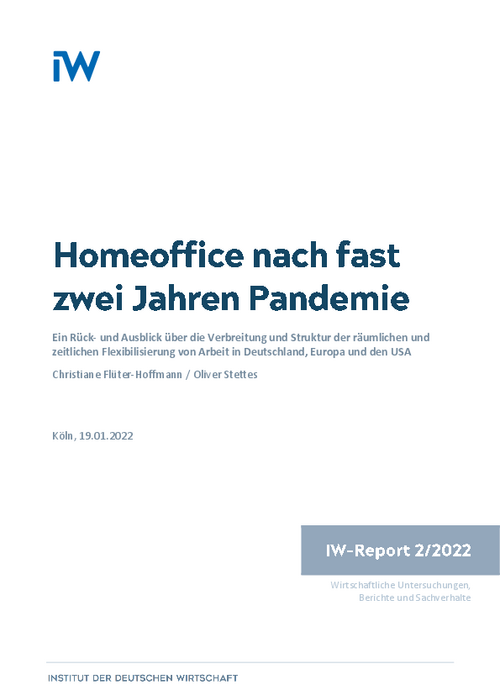This study presents a retrospective and an outlook on the spread and structure of the spatial and temporal flexibilization of work in Germany, Europe and the U.S.

Home office after almost two years of pandemic

This study presents a retrospective and an outlook on the spread and structure of the spatial and temporal flexibilization of work in Germany, Europe and the U.S.
For decades, numerous companies in Europe and the USA have been practicing flexible working schemes supported by digital technologies. As a preventive measure to protect against infection, working from home has gained a whole new significance in the last two years. The number of employees working from home increased by leaps and bounds, as did the number of studies from various fields of research that examined the framework conditions, the operational and political implications, and the opportunities and risks from the company and employee perspectives.
Whereas before the outbreak of the Corona pandemic 13 percent of the labor force and just under ten percent of all dependent employees in Germany worked from home at least occasionally, their number rose rapidly with the onset of the pandemic, with the first lockdown in March 2020. But also as a result of the compulsory work-from-home policy there was - at its peak in February 2021 - almost half (49%) of dependent employees in Germany working from home. In the European Union, an average of eleven percent of all dependent employees worked from home at least occasionally in 2019. In Sweden it was around one-third of all employees working from home whereas in Bulgaria just one percent. With the outbreak of the pandemic, the figures here also rose significantly: On average, about 42 percent of employees in the EU worked from home in February/March 2021, and nearly 60 percent in the Netherlands. In the U.S., the numbers vary widely depending on the kind of inquiry and coverage, from 15 to 37 percent of the U.S. workforce for the pre-Corona period. At the beginning of the pandemic period, in May 2020, 42 percent of the U.S. workforce was working from home. The number has since plummeted again.
In all countries, policymakers and business leaders are discussing how this flexible form of work will continue after the pandemic and what a new normal might look like then. The empirical evidence suggests that the prevalence of working from home will increase - not least because of shared positive experiences with working from home over the past almost two years. By contrast, where both employees and companies see their reservations about remote working confirmed, they will return to face-to-face work as soon as circumstances will permit. However, a special econometric analysis shows that there is one fifth of employees who are eligible to work from home as far as their tasks and their personal qualification is concerned but they are not allowed to do so. The analysis shows as well that this employee group differs in many workplace characteristics from employees who already work from home or who do not want to.
Companies and employees must therefore engage in a dialogue to balance operational necessities and individual concerns in order to find appropriate specific solutions on whether and how to work from home. In this context, it is important to find out which framework conditions are conducive to companies and employees in order to reconcile the job satisfaction and health of employees on the one hand and the competitiveness of companies with high productivity and well-functioning business processes on the other. The coalition agreement of the new German government might disequilibrate the balance of the effective and efficient negotiation process between companies and employees.

Home office after almost two years of pandemic

More on the topic

What factors influence the career ambitions of people with disabilities?
Many companies in Germany report having difficulties not only in recruiting employees, but also in filling vacant management positions.
IW
Leadership in transformation: Megatrends and management as a driver of change
Leadership dynamics in companies are subject to constant change in order to meet the challenges of their time. Today, the greatest influences result from developments such as demographic change, globalization, individualization, structural change and ...
IW